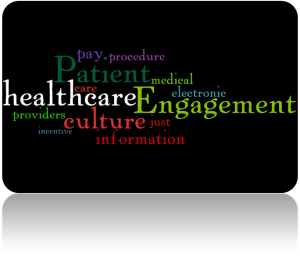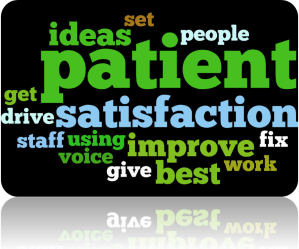
One of the latest healthcare buzzwords is “Engagement,” as in “Patient Engagement.” Unlike patient satisfaction, clinical care, customer service, and other service-oriented terms, Patient Engagement is a little more nebulous to the average healthcare consumer.
However, the term’s definition is abundantly clear to most healthcare institutions. In the article Patient engagement creates Stage 2 challenges for providers, Patient Engagement requires that “5% of patients be engaged in their care through an online portal or electronic medical record. Hospitals that don’t achieve 90 consecutive days of meaningful use at Stage 2 during the 2014 fiscal year will be penalized financially. They must do this to continue receiving their incentive payments and avoid losing 1% of future Medicare reimbursements.” Ouch!
Essentially the Federal Government has narrowly defined Patient Engagement as getting consumers to sign-in to a system with their electronic medical information. There are many reasons given why this is so difficult, and many suggestions followed: “Updating organizational policies addressing patient EMR access (particularly looking at gaps in the system); continuously educating patients and providers of their roles related to the engagement; making sure information is robust, including more than just appointment dates and lab results; staying current with standard development that supports consumer engagement; and eliminating patient fees for electronic health information.”
But much of this is missing one key point. The culture of America, in particular, revolves around the fact that we don’t have to directly pay for a significant portion of our healthcare. Sure, we pay premiums and pay taxes, but it’s not like paying cash for a car – where you either keep the $20,000 in your bank account or write a check today for $20,000. Many Americans pay virtually nothing out of pocket for a visit or procedure, and the others spend the vast majority of their healthcare expenses on premiums. We’re a culture that’s focused on requesting the best procedure and expecting physicians, hospitals, and other institutions to deliver the best care. Whether that happens or not is another debate, but that’s the current state of the culture.
Until this culture changes, Patient Engagement – as it’s defined by the government – will continue to be a challenge. I have had 2 medical procedures lately, and it was like pulling teeth (healthcare pun intended) to determine my out-of-pocket costs before the procedure. Even then, they were only rough estimates. There was no proactive sharing of that information on the part of the healthcare providers, so it was all on the customer to determine the cost and make an informed decision.
Also, I was asked to create a log-in to my EMR last year, but I was just given a copy of a detailed form with instructions; there was no incentive, no promotion – just “here’s the form if you want to login.” To change a culture, the provider has to share what’s in it for the patient to do something different, to begin changing behaviors.
For Patient Engagement to truly succeed, the culture has to change.
Did you like this post? Here are other Healthcare-related posts:
 In the article Hospital shows improved patient satisfaction, the author highlights a hospital that is using key strategies to drive up patient satisfaction. And in hearing Ivision Memorial Hospital leaders describe the approach, one starts to draw conclusions. Here are some quotes:
In the article Hospital shows improved patient satisfaction, the author highlights a hospital that is using key strategies to drive up patient satisfaction. And in hearing Ivision Memorial Hospital leaders describe the approach, one starts to draw conclusions. Here are some quotes:






















